@andy42 Huh? What you wrote really makes no sense to me, and I think you are confused on a couple things or getting mixed up on terminology.
Degrees can be used the describe the position of a note within a scale. For example: in the C Major scale (C, D, E, F, G, A, B, C) we have Root, 2nd, 3rd, 4th, 5th, 6th, 7th, Octave.
Degrees can also be used to describe the distance between 2 different notes chromatically (also called the Interval), ascending or descending. This is counted in half steps (each fret), NOT including the note started on.
So, a Chromatic Scale, starting on C ascending = C, C# (Db), D, D# (Eb), E (Fb), F (E#), F# (Gb), G, G# (Ab), A, A# (Bb), B (Cb), and C (B#) - see chart below.
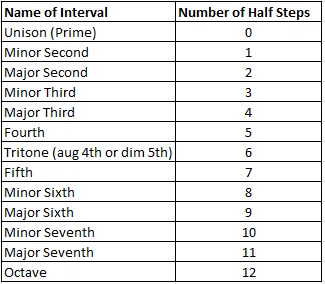
So, lets take a C Major Scale, for example.
When describing going from Root C ascending, going from C to G is a 5th, because it is the 5th note in the scale.
When describing the Interval between C to G, we are counting # of half-steps (again, not including the starting note). To get from C to G we are ascending 7 half-steps, which is called a Fifth (see chart).
I think your confusion comes from confusing the difference between those 2 descriptions.
Lets look at it on a fret-board chart:
This first image is showing the notes played in a C major scale in relation to the position of the note in that scale.
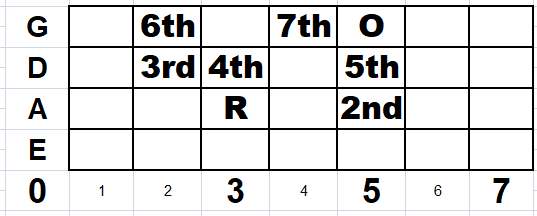
This image is showing the Intervals between the notes in a C major scale (in relation to the Root note of the scale):
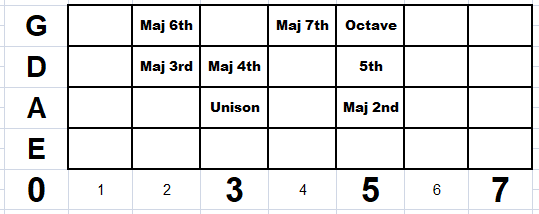
So, to answer your question. If we look at the above representation and want to know the Interval between the Octave (C) and the 5th (G) - ie., a descending Interval, we would count the number of half steps starting with the C on the G string to get to the G on the D string, which is 5 half steps. Thus, the G on the D string is the Fourth of the C on the G string because there are 5 half steps (descending) between the starting note and ending note.
I think this would make more sense when looking at a 5 string bass. The root is in red, the Octaves are in orange. Ascending from Root in half-steps is shown in positive numbers (also in same octave as root, except for the Octave which is one octave higher than our starting position), Descending from Root in half-steps is shown in negative numbers (lower octave).
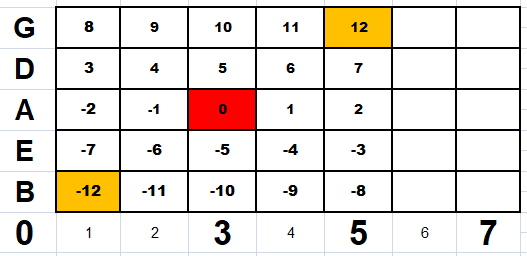
So, for your examples in your post.
-
Descending from 5th fret G string (C) to 5th fret D string (G) = Fourth (5 half steps lower), whereas ascending from 3rd fret A string (C) to 5th fret D string (G) = Fifth (7 half steps ascending), and so forth.
-
Descending from 9th fret G string (E) to 9th fret D string (B) = Fourth, ascending from 7th fret A string (E) to 8th fret D string (B) = Fifth.
-
Descending from 7th fret G string (D) to 7th fret D string (A) = Fourth, ascending from 5th fret A string (D) to 7th fret D string (A) = Fifth.
A bass guitar is completely symmetrical instrument. What is true in one area of the fret-board is true for another, there is no deviation.
To say this another way - when looking at the last picture:
- when going from 12 to 7 (5 half-steps descending) it is a Fourth
- when going from 7 to 12 (5 half-steps ascending) it is also a Fourth
- when going from 0 to 7 (7 half-steps ascending) it is a Fifth
- when going from 0 to -7 (7 half-steps descending) it is also a Fifth
- when going from -12 to -7 (5 half steps ascending) it is a Fourth
- when going from -12 to -5 (7 half-steps ascending) it is a Fifth
- when going from 0 to 5 (5 half-steps ascending) it is a Fourth
- when going from 5 to 0 (5 half-steps descending) it is also a Fourth
and so on.
![]() Mind blown. What gives? why wouldn’t the 7th fret follow the same logic as the 5th and 9th fret?
Mind blown. What gives? why wouldn’t the 7th fret follow the same logic as the 5th and 9th fret?



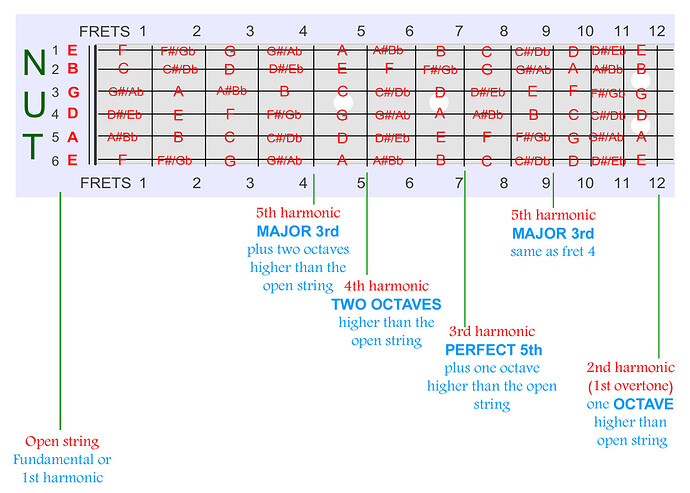

![What are Guitar Harmonics? & How to Play Harmonics [Lesson]](https://img.youtube.com/vi/8x-XJ5iPA3Y/maxresdefault.jpg)